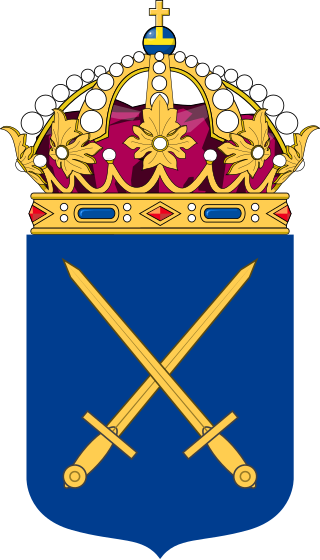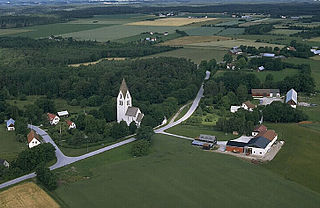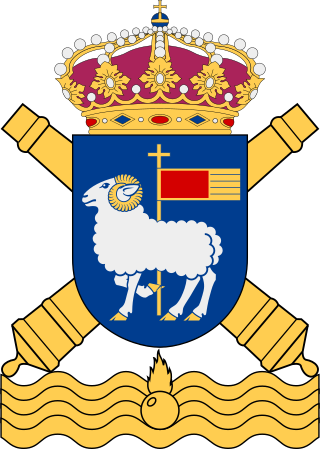
The Swedish Armed Forces is the armed forces of the Kingdom of Sweden. It consists of four separate military branches, the Swedish Army, the Swedish Navy, the Swedish Air Force and the Home Guard.

Region Gotland, officially Gotlands kommun, is a municipality that covers the entire island of Gotland in Sweden. The city of Visby is the municipality's seat. Gotland Municipality is the 39th most populous municipality in Sweden.

Gotland, also historically spelled Gottland or Gothland, is Sweden's largest island. It is also a province/county, municipality, and diocese. The province includes the islands of Fårö and Gotska Sandön to the north, as well as the Karlsö Islands to the west. The population is 61,023 (2024) of which about 23,600 live in Visby, the main town. Outside Visby, there are minor settlements and a mainly rural population. The island of Gotland and the other areas of the province of Gotland make up less than one percent of Sweden's total land area. The county formed by the archipelago is the second smallest by area and is the least populated in Sweden. In spite of the small size due to its narrow width, the driving distance between the furthermost points of the populated islands is about 170 kilometres (110 mi).

The Swedish Army is the land force of the Swedish Armed Forces of the Kingdom of Sweden in Northern Europe / Scandinavia. The army's history dates back to the Swedish War of Liberation in 1521.

Fredrik Henrik af Chapman was a Swedish shipbuilder, scientist and officer in the Swedish navy. He was also manager of the Karlskrona shipyard 1782–1793. Chapman is credited as the world's first person to apply scientific methods to shipbuilding and is considered to be the first naval architect.

Jonas Lidströmer (1755–1808) was a Swedish inventor and officer in the Swedish Navy. Lidströmer was born in 1755 at Lagfors bruk, Medelpad, and died 1808 in Stockholm. He was a colonel-mecanicus, head of the mechanical state of the Royal Swedish Navy, Royal Inventor and advisor to the king, Knight of the Order of Vasa and eventually knighted Lidströmer.

Olof Rudolf Cederström was a Swedish naval commander. Cederström enlisted in the Swedish admiralty in 1779 and as captain, he conducted a raid against Rogervik. He distinguished himself in 1790 at the naval Battle of Reval and the Battle of Viborg Bay. During the following years he led ships against privateers in the North Sea. He was sent in 1801 to fight alongside the United States Navy in the Mediterranean during the First Barbary War. In 1808 his ships were sent to blockade Gotland in order to repel a Russian invasion. His last military action was against Denmark and France in 1813, when he helped Swedish forces capture Vorpommern. In 1815, he was appointed a minister but returned to the navy in 1818. He finally resigned in 1828.

The Gotland Artillery Regiment was a Swedish Army artillery regiment that was in active service between 1811 and 2000. The regiment was based in Visby as part of the Gotland Garrison.

Kräklingbo is a populated area, a socken, on the Swedish island of Gotland. It comprises the same area as the administrative Kräklingbo District, established on 1 January 2016.

Mästerby is a populated area, a socken or administrative parish, on the Swedish island of Gotland. It comprises the same area as the administrative Mästerby District, established on 1 January 2016.

Lärbro Church is a medieval church in Lärbro on the Swedish island of Gotland. The church is located at a former strategically important spot, as testified by the adjacent fortified tower. The presently visible Gothic church replaced an earlier Romanesque church during the 13th and 14th century. The cemetery of the church contains several graves of victims from Nazi concentration camps who were taken to a field hospital in Lärbro during and after World War II.

The presence of the military on Gotland results from the Swedish island's strategic military importance in the Baltic Sea for most of the nation's history. Gotland has been fortified in stages since the 13th century.
Carl Bertil Myrsten was a Swedish director and ship-owner.
The Defence Act of 2000 was a defence act passed by the Swedish Riksdag on 30 March 2000, and the largest reorganisation of the Swedish Armed Forces since the Defence Act of 1925. The act was a continuation of the policies set in motion by the Defence Act of 1996: shifting the military's focus from the defence of Swedish territory to a more flexible "operational defence* for smaller-scale peacekeeping operations in foreign nations. Many military formations were disbanded as a result.

The Gotland Coastal Artillery Regiment, designation KA 3, was a Swedish Navy coastal artillery regiment of the Swedish Armed Forces which operated between 1937 and 2000. The unit was based in Fårösund in Gotland.

The Invasion of Gotland was a Danish sea-borne invasion of the Swedish island of Gotland in the Baltic Sea, led by admiral Niels Juel during the Scanian War. The invasion took place from 28 April to 1 May 1676.
A War in Gotland or Invasion of Gotland may refer to:
The War in Gotland (1403–1404) was a conflict between the Kalmar Union and the Teutonic Order. The war was a failure for Margaret, and the island stayed in Teutonic hands until they eventually sold the island in 1407.














